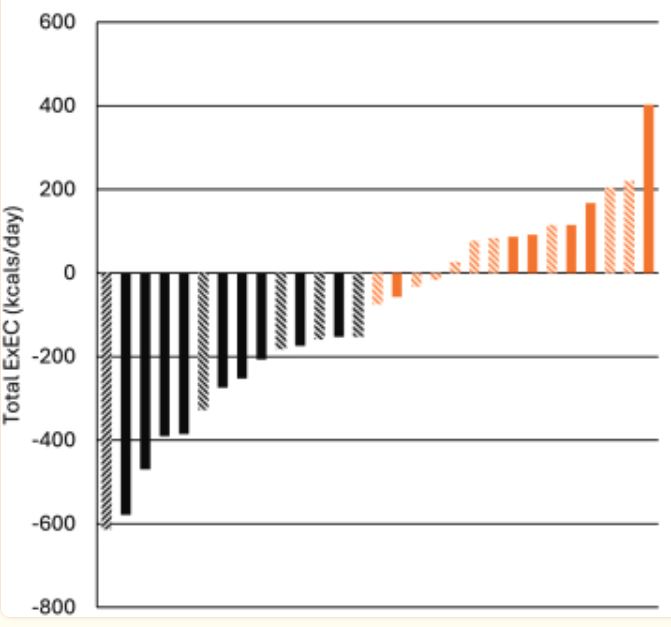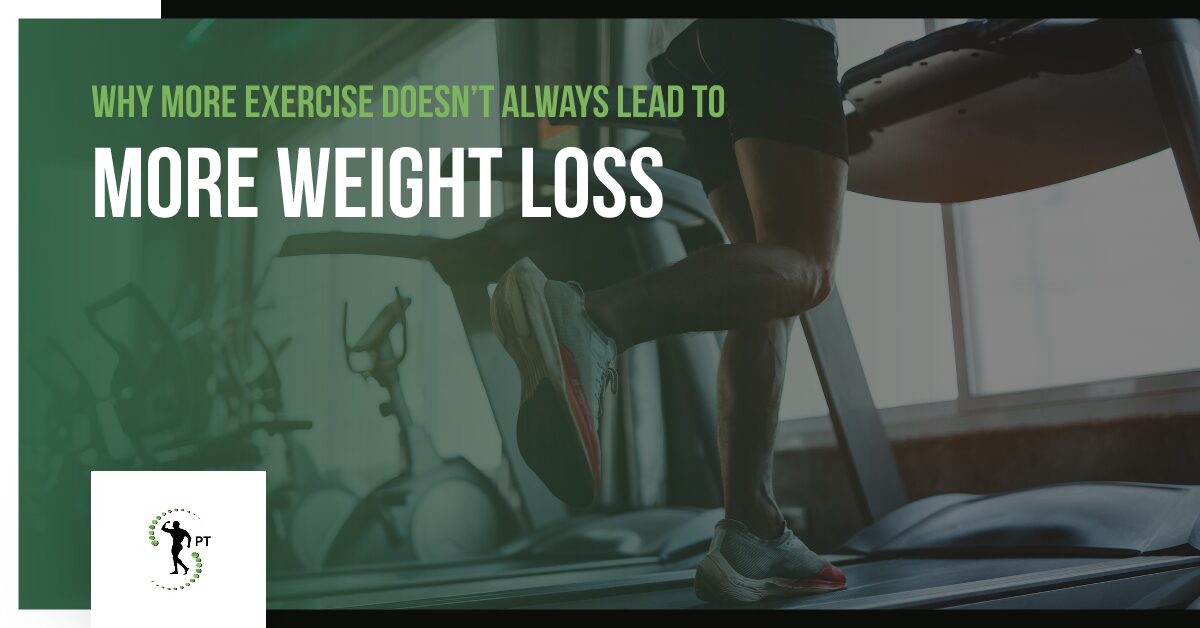We’ve known for years that exercise as well as caloric restriction can induce compensatory changes in non-exercise activity thermogenesis (NEAT), and to a lesser degree resting energy expenditure (1,2).
However, what remains unclear is:
1) What specifically causes this to occur
2) Why some people are more affected by these compensatory changes than others
I see this play out all the time in the real world. With some clients I barely have to reduce their caloric intake during a weight loss phase, and they can continue losing weight for months on end just by gradually increasing their activity level.
But for other clients this same strategy just doesn’t seem to work as well. With these clients I usually need to take their calories considerably lower, even when we increase their activity level.
A very recent study by Flanagan et al. shed some new light on this topic (3). The researchers divided participant into a high or low dose aerobic exercise group and sought to identify and characterize individuals who exhibit greater exercise energy compensations. The high dose exercise group expanded approximately 2000 kcal per week while the low dose group expanded about 800 kcal per week.
What I really like about this study is that they used gold standard testing for everything. Exercise energy expenditure (EEE) was measured in real time for each session, resting energy expenditure (REE) was measured in a metabolic chamber, and total daily energy expenditure (TDEE) was measured using doubly labeled water.
After 24 weeks the mean weight loss across all participants was −1.2 ± 3.0 kg, although it ranged from −9.8kg +7.5 kg. Of the total participants about half were classified as compensators while the other half were classified as non-compensators.
On average, the compensators expended about 300 kcal less than predicted per day, although in some compensators it was as high as 600 kcal per day.
In the non-compensators, total daily energy expenditure was on average about 100 kcal higher than predicted and in some participants, it was as much as 400 kcal per day above predicted.
This is shown in the graph below adapted from the study (3).

There was no significant difference in weight change between compensators and non-compensators. However, the majority of participant who exhibited compensation were in the high dose exercise group. That means they performed a lot more exercise to achieve the same amount of weight loss, which wasn’t a lot.
Now, here is where things get interesting. Resting energy expenditure in the compensators, as measured in the metabolic chamber, did not change. Exercise energy expenditure also did not change since that was tightly controlled. That means the decrease in predicted energy expenditure must be coming from a reduction in NEAT or spontaneous physical activity.
However, it was reported that minutes spent in physical activity as measured through a SenseWear armband did not actually decrease.
This then begs the question – where is that 300-600 kcal reduction in daily energy expenditure coming from?
The researchers speculated that the reduction is likely coming from an increased economy of effort during low-intensity activities. This is indeed a very plausible explanation, and one that makes sense.
Previous studies have demonstrated that exercise can make the body more efficient at conserving energy during low intensity activities, such as regular day to day tasks (4).
But this still doesn’t tell us much about why this occurs, and why some people seem to be much more impacted that others.
In the present study, what the researchers found was that those individuals with higher baseline physical activity level exhibited greater compensation, indicating that they had less potential to increase their energy expenditure. Similar findings were observed in another study by Wang et al (5).
This is in with the constrained model of physical activity, which suggests that total daily energy expenditure is not additive but is a relatively constrained product of our evolved physiology and does not increase with physical activity in a dose-dependent manner (1.2).
Although it wasn’t measured in the present study, this is likely mediated by increased mitochondrial efficiency and decreased sympathetic nervous system drive to the muscles.
While it may be possible to overcome this increased metabolic efficiency and reduced sympathetic drive by adding in even more exercise, for most people this is simply not practical, and they may run into issues with recovery unless their sleep, nutrition, and stress management is on point.
Therefore, if you’re already doing a moderate amount of exercise, and your daily habitual activity is already quite high, you probably won’t see much additional weight loss from adding in more exercise.
You’d be better off keeping your exercise volume moderate and reducing your caloric intake slightly.
While you’re still like to experience energy compensation from reducing your caloric intake, studies show that energy compensation in response to exercise induced energy deficits appear to be larger (6).
Energy compensation also appears to be greater for longer duration interventions, independent of whether the energy deficit is induced through diet or exercise (6).
That is why I’ve said time and time again – you shouldn’t live in caloric deficit. If you’ve got a lot of weight to lose you should break up your diet into phases to allow your body to stabilize in between.
References
- Pontzer H. Constrained Total Energy Expenditure and the Evolutionary Biology of Energy Balance. Exerc Sport Sci Rev. 2015 Jul;43(3):110-6. doi: 10.1249/JES.0000000000000048. PMID: 25906426.
- Pontzer H, Durazo-Arvizu R, Dugas LR, Plange-Rhule J, Bovet P, Forrester TE, Lambert EV, Cooper RS, Schoeller DA, Luke A. Constrained Total Energy Expenditure and Metabolic Adaptation to Physical Activity in Adult Humans. Curr Biol. 2016 Feb 8;26(3):410-7. doi: 10.1016/j.cub.2015.12.046. Epub 2016 Jan 28. PMID: 26832439; PMCID: PMC4803033.
- Flanagan EW, Sanchez-Delgado G, Martin CK, Ravussin E, Pontzer H, Redman LM. No evidence for metabolic adaptation during exercise-related energy compensation. 2024 Apr 29;27(6):109842. doi: 10.1016/j.isci.2024.109842. PMID: 38947494; PMCID: PMC11214370.
- Woo JS, Derleth C, Stratton JR, Levy WC. The influence of age, gender, and training on exercise efficiency. J Am Coll Cardiol. 2006 Mar 7;47(5):1049-57. doi: 10.1016/j.jacc.2005.09.066. Epub 2006 Feb 9. PMID: 16516092.
- Wang X, Bowyer KP, Porter RR, Breneman CB, Custer SS. Energy expenditure responses to exercise training in older women. Physiol Rep. 2017 Aug;5(15):e13360. doi: 10.14814/phy2.13360. PMID: 28774950; PMCID: PMC5555889.
- Doucet É, McInis K, Mahmoodianfard S. Compensation in response to energy deficits induced by exercise or diet. Obes Rev. 2018 Dec;19 Suppl 1:36-46. doi: 10.1111/obr.12783. PMID: 30511511.







